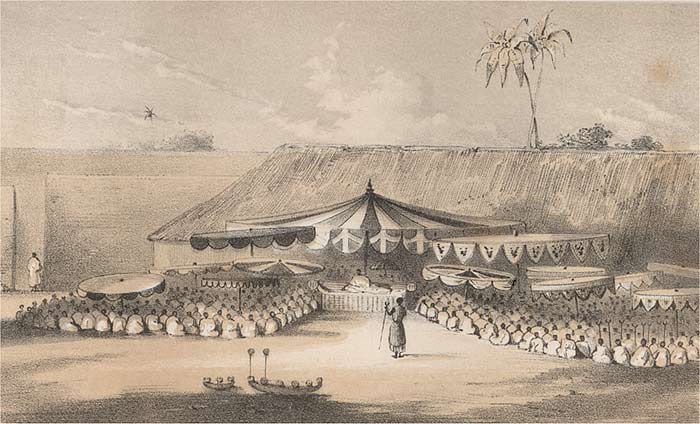INTRODUCTION
In the Second Millennium AD West Africa was a very interesting place on Earth. In Nigeria, kingdoms were already established by 1000 AD. Far to the North lay the Islamic empires. By the close of the 15th Century European ships appeared from the sea.
The Islamic world was interested in the gold, ivory and slaves of West Africa. The Europeans held the same interest. In the 18th century several 100,000s slaves were bought from Dahomey in Bénin and other kingdoms and carried to the Americas to work in plantations. Luxury foods - like coffee and sugar - from America were sold in Europe. From Europe, the African kings bought guns and alcohol and many other items.

Ruins of the royal palace in Abomey.
The Kingdom of Dahomey was established around the capital of Abomey in the mid17th century by princes from Allada (to the South) in search of new land. The earlier history of the region is almost unknown. The Dahomeans state was extremely highly organized - even without writing. From behind the moats of Abomey - thirteen kilometres long - the princes kept an eye on all affairs in the small kingdom. The military was highly important. Due to shortage of labour, even female regiments were employed. In 1724 Dahomey conquered Allada, and in 1727 Whydah (Ouidah), the main slave-exporting port on the coast. Thus, Dahomey became central in dealings with the Europeans, who had established trading lodges in Whydah; right up till the middle of the 19th century, slaves still went to Brazil. The first European power to abolish trading in slaves was Denmark (in 1791/1792). Denmark was also the first country to establish plantations in Africa for products exported to Europe (1788).

The first discovered cave at Agongointo.
The Dahomean princes took a strong interest in agriculture. They built huge “royal palaces” in and outside Abomey. These establishments were actually slave-run estates; the first were founded in the late 17th century. The estates provided produce that could also be sold internationally, for instance palm-oil. The Dahomean kingdom may therefore have developed further along its own lines. However, in 1892, the French conquered Abomey, and Independence was only won by the much larger state of Dahomey, now Bénin, in 1960.
The old Kingdom of Dahomey was never forgotten. Traditions were kept in high respects in spite of modernization, including the voudouns, and the Fon language spoken, of course. Historical studies of the Dahomeans are plentiful, but the archaeological exploration of the kingdom - like of all Bénin - has only just begun.

Religious ceremony in Abomey in 1850, after Forbes 1851.

Religious ceremony in Abomey in December 2003.
Ancient settlements, iron-production sites, and graves have been found, Abomey has been further investigated, and the many and large Royal Palaces with their tall walls studied. Surprising new discoveries comprise man-made subterranean structures in the thousands: The very reason for establishing the open-air museum at Agonguinto.
